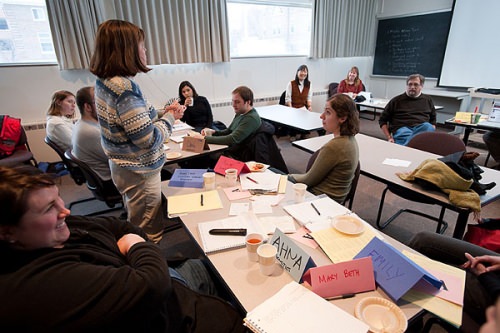Familiar faces of teaching and learning create cross-campus collaborative
Familiar faces from across campus are coming together to provide new opportunities to support teaching and learning under an administrative structure that will deepen partnerships and collaboration between established programs.
Starting with the fall semester, the UW-Madison Collaborative for Advancing Teaching and Learning will bring together seven previously independent units: the Delta Program in Research, Teaching and Learning; the Office of the Provost; the Office of Undergraduate Advising; Madison Teaching and Learning Excellence; the UW Teaching Academy; the Wisconsin Collaboratory for Enhanced Learning (WisCEL); and the Wisconsin Institute for Science Education and Community Engagement (WISCIENCE).
“The Teaching and Learning Collaborative will provide strategic alignment to cross-campus teaching and learning initiatives, professional development for faculty, staff and graduate students, programming to support learning within and beyond the classroom, and a coordinated administrative structure for units currently scattered across campus,” says Steven Cramer, vice provost for teaching and learning.

Delta Program in Research students participate in small group discussions during a class in 2009. The Delta program and six other units are coming together in the newly created UW–Madison Collaborative for Advancing Teaching and Learning. Photo: Jeff Miller
The collaborative will cultivate ties with schools and colleges, and make valuable teaching and learning resources easier to find and understand.
A key feature of the group is the retention of the member units’ identities and missions within the new central framework. The collaborative provides an opportunity for these units to be more than the sum of their parts. They will be able to enhance the exchange of insights and expertise through closer coordination and collaboration.
“Working together as a collaborative will provide new synergies and opportunities to enhance student learning through faculty and staff engagement,” says Janet Branchaw, assistant professor in the Department of Kinesiology, and director of WISCIENCE.
The Wisconsin Experience, which makes a UW–Madison education particularly valuable and unique, will be the guiding principle for the services and opportunities provided by the units within the collaborative.
A renewed campus attention to teaching and learning originated in the early 1990s when UW–Madison took a hard look at its learning opportunities and decided that it needed a campus conversation on teaching and learning excellence. The Faculty Senate created the UW Teaching Academy to foster these conversations. A number of other efforts emerged to reemphasize the importance of the university’s teaching mission.
As the teaching and learning culture developed on campus, the diverse units of the Teaching and Learning Collaborative grew organically from the creative endeavors of faculty and staff. Some arose as a result of external grants that encouraged ongoing commitments to institutionalize the innovation when the grant expired. Others grew out of internal funding, such as the Madison Initiative for Undergraduates, which involved students, faculty and staff selecting projects to enhance the learning environment at UW–Madison.
To date, these seven cross-campus teaching and learning units have been distributed under various larger host units. While accommodating independent creativity, the distributed nature has posed challenges to those trying to navigate services provided by the different units. The new, more connected and integrated structure will yield synergy and efficiency, further advancing the teaching and learning mission.



